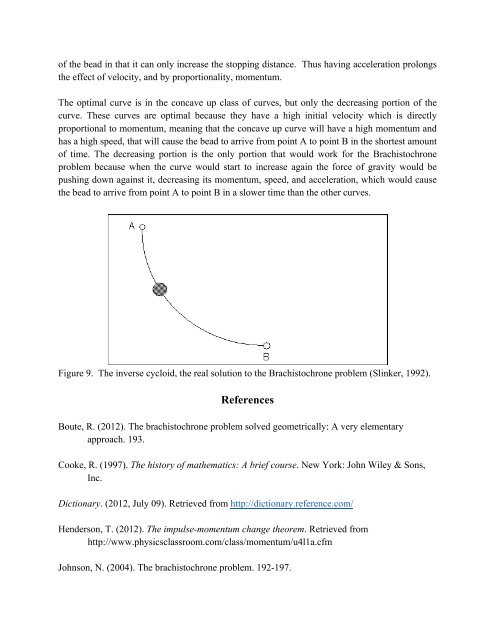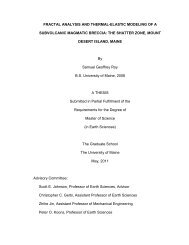Exploring the Methods of Differential Calculus through the ...
Exploring the Methods of Differential Calculus through the ...
Exploring the Methods of Differential Calculus through the ...
You also want an ePaper? Increase the reach of your titles
YUMPU automatically turns print PDFs into web optimized ePapers that Google loves.
<strong>of</strong> <strong>the</strong> bead in that it can only increase <strong>the</strong> stopping distance. Thus having acceleration prolongs<br />
<strong>the</strong> effect <strong>of</strong> velocity, and by proportionality, momentum.<br />
The optimal curve is in <strong>the</strong> concave up class <strong>of</strong> curves, but only <strong>the</strong> decreasing portion <strong>of</strong> <strong>the</strong><br />
curve. These curves are optimal because <strong>the</strong>y have a high initial velocity which is directly<br />
proportional to momentum, meaning that <strong>the</strong> concave up curve will have a high momentum and<br />
has a high speed, that will cause <strong>the</strong> bead to arrive from point A to point B in <strong>the</strong> shortest amount<br />
<strong>of</strong> time. The decreasing portion is <strong>the</strong> only portion that would work for <strong>the</strong> Brachistochrone<br />
problem because when <strong>the</strong> curve would start to increase again <strong>the</strong> force <strong>of</strong> gravity would be<br />
pushing down against it, decreasing its momentum, speed, and acceleration, which would cause<br />
<strong>the</strong> bead to arrive from point A to point B in a slower time than <strong>the</strong> o<strong>the</strong>r curves.<br />
Figure 9. The inverse cycloid, <strong>the</strong> real solution to <strong>the</strong> Brachistochrone problem (Slinker, 1992).<br />
References<br />
Boute, R. (2012). The brachistochrone problem solved geometrically: A very elementary<br />
approach. 193.<br />
Cooke, R. (1997). The history <strong>of</strong> ma<strong>the</strong>matics: A brief course. New York: John Wiley & Sons,<br />
Inc.<br />
Dictionary. (2012, July 09). Retrieved from http://dictionary.reference.com/<br />
Henderson, T. (2012). The impulse-momentum change <strong>the</strong>orem. Retrieved from<br />
http://www.physicsclassroom.com/class/momentum/u4l1a.cfm<br />
Johnson, N. (2004). The brachistochrone problem. 192-197.
















